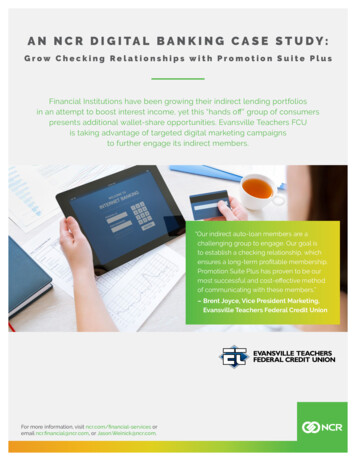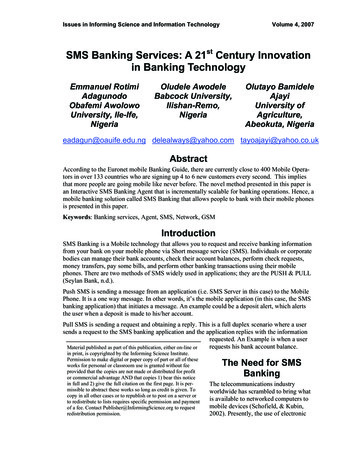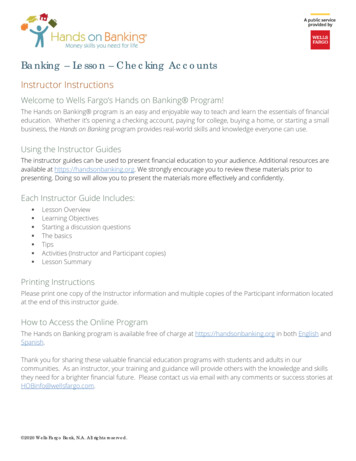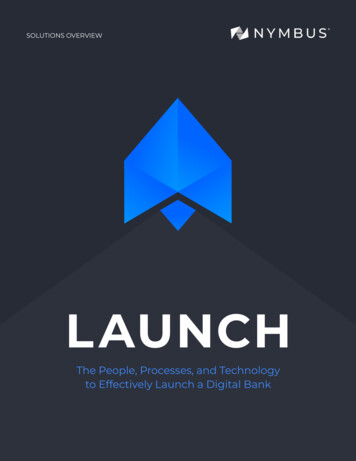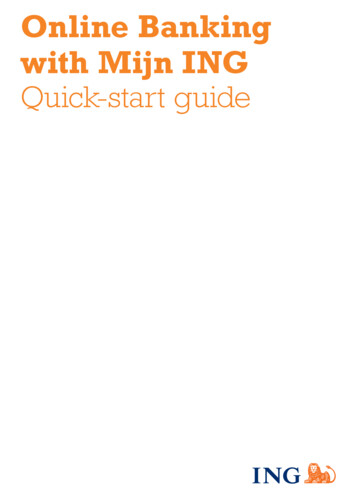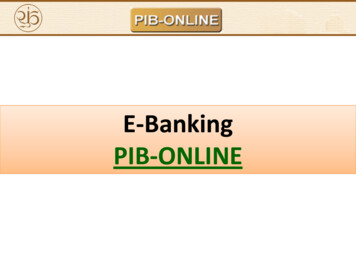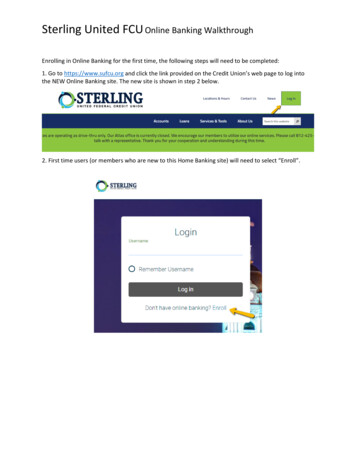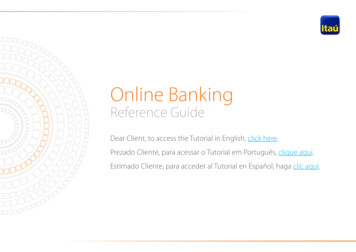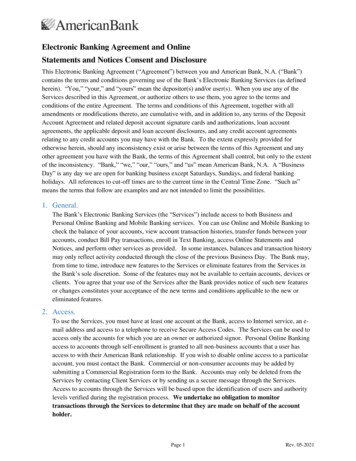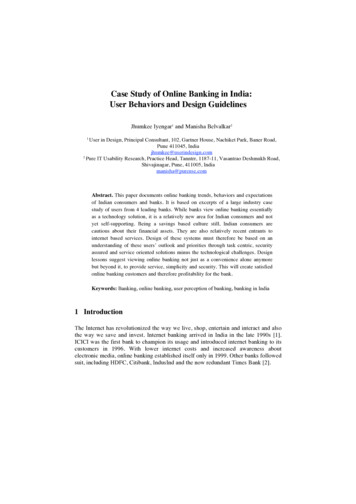
Transcription
Case Study of Online Banking in India:User Behaviors and Design GuidelinesJhumkee Iyengar1 and Manisha Belvalkar21User in Design, Principal Consultant, 102, Gartner House, Nachiket Park, Baner Road,Pune 411045, Indiajhumkee@userindesign.com2Pure IT Usability Research, Practice Head, Tanntrr, 1187-11, Vasantrao Deshmukh Road,Shivajinagar, Pune, 411005, Indiamanisha@pureuse.comAbstract. This paper documents online banking trends, behaviors and expectationsof Indian consumers and banks. It is based on excerpts of a large industry casestudy of users from 4 leading banks. While banks view online banking essentiallyas a technology solution, it is a relatively new area for Indian consumers and notyet self-supporting. Being a savings based culture still, Indian consumers arecautious about their financial assets. They are also relatively recent entrants tointernet based services. Design of these systems must therefore be based on anunderstanding of these users’ outlook and priorities through task centric, securityassured and service oriented solutions minus the technological challenges. Designlessons suggest viewing online banking not just as a convenience alone anymorebut beyond it, to provide service, simplicity and security. This will create satisfiedonline banking customers and therefore profitability for the bank.Keywords: Banking, online banking, user perception of banking, banking in India1 IntroductionThe Internet has revolutionized the way we live, shop, entertain and interact and alsothe way we save and invest. Internet banking arrived in India in the late 1990s [1].ICICI was the first bank to champion its usage and introduced internet banking to itscustomers in 1996. With lower internet costs and increased awareness aboutelectronic media, online banking established itself only in 1999. Other banks followedsuit, including HDFC, Citibank, IndusInd and the now redundant Times Bank [2].
Internet banking changed both the banking industry as well as banks’ services to itscustomers. ‘Anywhere banking’ came to be recognized as an opportunity also fordifferentiated and competitive services. Ancillary online services like checkingaccount status, fund transfer, ordering demand drafts, loan applications, credit cardverifications, shopping portals etc. as well as not requiring a visit to the branch duringoffice hours were viewed as high-value offerings and increasingly started to become anecessity rather than a service.Once banking institutions recognized the low processing cost per transaction viathe internet, they began viewing online banking as an extension of the bank ratherthan as an add-on service. The motivation to introduce online banking now alsoincluded new business potential, additional funds from new and existing customers,expansion in geographical reach, image as a tech-savvy bank especially if targetingthe youth and the threat of customers shifting loyalty if they did not introduce it [3].Nationalized banks initially viewed online banking as insecure and counterintuitiveand were therefore hesitant. But eventually, SBI, Canara Bank, Allahabad Bank,Punjab National Bank, Bank of Baroda, Syndicate Bank and others introduced it. SBIlaunched internet banking in 2001 and experienced good response. In general, internetbanking saw an exponential rise in users [4].Today, banks encourage their customers to use online banking. Besides cost andrevenue impacts, this paradigm shift is because they also recognize that self-controltransactions have greater potential for customer satisfaction and retention. Onlinebanking has thus come to be among essential banking services.The approach to adopting online banking however is often to merely stay abreastof industry and technology and online banking is becoming a separate business unitdriven by technological possibilities. The user often has minimal place in such anapproach as evidenced by non-human centric experiences that flourish. However, thecultural and organizational shift needed by Indian banks to draw old customers intothis new banking channel as well as to draw new customers requires a user centricfocus.But how much have banks paid attention to the user? How is the overall experienceand how do customers perceive their bank as they struggle unaided in the comfort oftheir homes? How cognizant are banks that customers silently leave after gettingfrustrated? Do they measure how much revenue they are losing because of atechnology focused approach to online banking? How do Indian consumers behave inthis dichotomy between technology barrier and convenience?2 Indian Banking Industry and Online Awareness of its User BaseA large chunk of the Indian banking industry still belongs to the public sector bankshaving the most extensive network of physical branches. These are followed by largeprivate banks and lastly by multinational banks (MNC) who have the smallestphysical network and therefore their online banking needs to be the most developedand able to address user needs without requiring human intervention. This is depictedin Figure 1. The fact that most government organisations have their payroll accountswith public sector banks contributes significantly to the large customer bases of these
banks. Traditional public sector banks have existed for many years and have serviceddiverse income groups. This has resulted in their customer base being huge as well asbelonging to a wider demographic representation, given India’s heterogenouspopulation as well. However, most of the traditional customers prefer to bank with a‘bank with a human touch’ and prefer public sector banks as they form an emotionalrelationship with their bank personnel, which is not really encouraged by privatesector or multi-national banks [5].Fig 1 Indian Banking Scenario(representative only, not to scale)Fig 2 Indian Internet Banking Landscape(representative only, not to scaleThe new generation which has been banking for less than a decade prefers fastertransactions and more professional relationships as compared to the traditional)customer. For them, opening a bank account is incidentaland connected to their directdeposit salary accounts. The private sector bank has captured the corporates and ITsector as compared to the public sector bank. As a result, banks in the public sectortend to have a huge user base, but very few of their customers have the technologyorientation or the inclination to use electronic media for banking. This is depicted inFigure 2. Therefore, the awareness of customers of public sector banks about onlinebanking as an active banking tool is relatively lower. To tap this type of user base thathas an inherent barrier to and not an obvious need for internet usage, just adding aninternet banking channel to a bank’s lists of services may not be enough of anincentive. A streamlined, simple and customer satisfaction oriented approach toservice novice users only can help banks achieve better internet banking penetration.3 User Research Study3.1 ObjectivesUser research studies of four banks were conducted to understand users’ currentrelations with their bank, their perception of offline and online banking services andto offer recommendations for more customer-focused services. We specificallyinvestigated:
Users’ offline and online expectations of their bank and association with itsbrandHomepage as a touch point for encouraging online bankingCustomer engagement barriers for online banking servicesConcept of new online services like branchless banking3.2 MethodologyThe methodology involved recruiting and studying users from the banks’ customerdatabase, categorized on the basis of usage and transactional behaviours. The 3 typesof users interviewed were: Non-users who don’t bank online Users who bank online but only check account status and don’t do anytransactions Users who perform extensive online transaction via their bank accountTable 1 Classification of studies conducted and methodology appliedNo.Objective of Study1.Offline and onlineexpectations and associationwith the brand2.3.4.Homepage as touch pointfor encouraging onlinebankingIdentify customerengagement barriers inonline bankingConcept Testing for newonline servicesMethod andTechniquesQuantitative researchNo ofUsers800CitiesQualitative research96Mumbai,Ahmedabad,Delhi, JaipurUsability Test andOne-on-one Interview48Mumbai, PuneUsability Test andOne-on-one Interview48Mumbai, PuneFocus GroupDiscussion48Bangalore,Mumbai, Delhi4 Findings: User Perceptions and Attitudes to Online BankingIn response to how they perceived their general banking experience, users mentionedrequirements mentioned below that have been detailed in Table 2: zero minimum balancepresence of ATM ‘everywhere’ (redundant now as all ATMs are connected)proximity from home/workfast growing and high savings interest ratesair-conditioned interiorsresponsive banking
Table 2 User perceptions and expectationsPriorityUsers’ PerceptionTotal123Zero minimum balance41013595640Presence of bank’s ATM“everywhere37215058580Proximity from home/work220115105440Fast growing and high savingsinterest rates7755228360Air-conditioned interiors4080200320Responsive banking15160125300Base – 800 respondents (Multiple responses)It was seen that the ability to bank without visiting the branch was a high priority.Responses to queries about their online banking experience, expectations andconcerns by user segments have been generalized and detailed in Table 3 below.Table 3 Issues of different types of users with online d about security ofsensitive informationFelt lost in content jungleLooked for error-freetransaction experienceFound the entire processcomplexConcerned about onlinesecurityValued advanced optionsthat saved timeAbsence of an online demo forinitiation is a roadblockDid not find clear directions& action pointsWanted online, the entirespectrum of services of thebankBroadly, all users emphasized 3 major attributes they considered important for theironline banking experience: Simplicity, Security, Service.
4.1 SimplicityUsers and non-users expect online banking to be further simplified than what they seetoday. Some expectations: Better link label clarity suggestive of action required Better navigation that highlights and presents relevant information incontext and at the right time needed Better content partitioning according to popularity and priority of action4.2 SecurityNon-transactors and non-users reported that they did not transact online because: concerns about the security of their banking information is not fully addressed technical glitches and unreliability create confusion and anxiety additional security gateways were absent4.3 ServiceAlmost all transactors demanded better service. They wanted: More services to be available online Better and faster customer support channels like online chat to solve bankinghurdles Innovative and intuitive interfaceThis is depicted in Figure 3 below.Fig 3 Users' emphasis on attributes according to their usage
5 Banking Industry Perspective and Approach to UsersBased on our client interactions before and after the studies, we found that banks viewonline banking as an important medium of servicing its customer base. While theyrecognize it as a direct cost savings, they do not necessarily recognize it as a point ofservice and hence do not give it the attention they give customer service at the branchwhere they take great pains to satisfy the customer, and to address the smallest ofqueries common in live banking.A simple example is their changing banking terminology without realizing itsimpact on the customer that can leave an average customer baffled. A label like ‘Emonies National Funds Transfer’ is very confusing for the customer. Changing it to asimpler ‘Funds Transfer’ reduces confusion and allows the customer to complete theirtransaction. Another example is use of marketing gimmicks resulting in loss ofusability. If other banking portals have a link called ‘SMS Alert’, then coining asimilar link called ‘InstaAlert’ only serves to create confusion.Manybankshavenowunderstood that online bankingis here to stay and that they needto upgrade and enhance theirofferings for simple solutionsand desired security to retain andattract customers [6]. They alsoneed to recognize that they mustoffer the same convenience andservice that people have come toexpect at the branch as well as inother areas of their life likeshopping online [1]. Payment forshopping too requires users toFig 4 Services offered via various banking channelsinvariably go through the onlinebanking portals. Banks need to also understand that transition of a new user to anadvanced one is a gradual process that needs to be supported by encouraging users toexplore with confidence by offering intuitive processes and user-friendlynomenclature. Only when users feel confident with the system, will it be easy forthem to explore new services through cross-sell banners and other means that arepopular and successful in banking.Banks are however yet to regard online banking as a ‘person-less’ service counterwhere the user is left to fend for himself/herself amidst stiff usability barriers andrealize that it costs them. The attention they accord their other points of service aretherefore deficient in online. (See Fig. 4) Setting up the hardware for online banking,which is viewed as the end point for the bank is often the beginning from a user’sperspective. That a methodical user-centric rather than a technology-centric designapproach is a systemic investment that creates satisfied customers, reduces costs andincreases revenue is yet to be accepted by the banking industry.
6 Design Lessons and RecommendationsBanking is a task-focused activity and also deals with people’s money. Both needease of use and psychological comfort of the user as fundamental requirements, forexample, giving feedback like ‘your money will be transferred in 24 hours’. Itspecifically needs a clear task flow, clarity of language and terminology and supportavailable at all times. Further, if a task completion process is intuitive and logical, theuser is more likely to gain confidence and increase usage of the internet for all theirbanking needs, thus increasing revenue potential for the bank. An online demo of theservice is an easy way to address both the task centric nature of banking as well asaddress the comfort level of the wide variety and vast numbers of novice users.An example of customer focused online banking would be specialized banking forthe Islamic community. It is a huge business opportunity. To capitalize on thatopportunity, banks must understand and design for highly specialized user behavior,expectations and critical aspects of the various Islamic cultures. Many Islamiccultures are exceptionally collective in decision-making and tend to be more concreteand risk-averse [7].There is a wide variety and large numbers of novice users among Indian onlinebanking customers today. Their view goes beyond the novelty of online banking.They expect their experience to be similar to what they get at a service counter. Theunfamiliar virtual experience cannot be completely different from their familiarphysical experience. Indian users have shown their readiness to accept online bankingas a sales channel by purchasing through cross selling online. But this is possible onlyif they are able to navigate the bank site. Banks need to view and reflect this throughthoughtful designs of their offerings. While banks have clarity of their marketsegmentation, they must progress to behavior-based segmentation and user-centredmethods and move beyond predesigned technology solutions. Online banking designmust create a 'quick in and out' experience, ensure success in transactions usersundertake, arouse curiosity and attract the customer to explore. Studying users,defining user types, benchmarking designs and testing for ease of use are critical forthis. Specific needs therefore are: clear task flows, brevity and clarity of language andterms, basic functions made obvious to average users and support available at alltimes. Besides short-term solutions, the long-term strategy needed is to not just createbut also measure user performance with the design to ensure it is self-evident andtransactions are truly self-controlled.7 ConclusionsIt is clearly in the interest of banks to encourage their customer base to use onlinebanking. Current designs of online banking systems do not address users’ needs andexpectations of online banking. User-centred design methods can achieve this.Internet, phone, paper, statements, ATM and visit to the branch all need to appear asone holistic experience [8] for the customer who is ‘anybody. In India, banking, likeseveral other transactions, continues to be relation-based and in need of humanassurance and intervention, technology notwithstanding. Hence this is particularly
significant. True benefits will be seen when banks use this technology to offloadcustomer service costs and increase sales by maximizing self-service. As 21st centurybanking users entrust the care of one of their most important assets to cyber space, aseamless, stress free and successful experience is essential. Design with users’ successas focus, content understandable by ‘anybody’, supported with demos and help toreduce intimidation, will justify investment in online through increased usage bysatisfied customers.References:1. Srivastava, Dr. Saurabh Internet Banking - A Global Way to Bank!,www.indianmba.com/Faculty Column/FC908/fc908.html2. De, Rajneesh and Padmanabhan, Chitra for Indian Express Group, Internet opens newvistas for Indian banks, html3. Singh, R. P. Whither Internet Banking in . The Indian internet Banking dies/banking1.htm5. Singh, Karan Manveer Public sector banks score over private rName 20061231&FileNAme news&sid 3&sec id 46. Kekre, Priya Phishing in India on the -in-India-on-the-rise/301008112099/0/7. Shaffer, E. The Evolving Institutionalization of Usability, a White Paper,www.humanfactors.com8. Merholz, P., Wilkens, T., Schauer, B., Verba, D. Subject To Change: Creating GreatProducts & Services for an Uncertain World9. Norman, D., Emotional Design: Why We Love (or Hate) Everyday Things
Case Study of Online Banking in India: User Behaviors and Design Guidelines Jhumkee Iyengar1 and Manisha Belvalkar2 1 User in Design, Principal Consultant, 102, Gartner House, Nachiket Park, Baner Road, Pune 411045, India jhumkee@userindesign.com 2 Pure IT Usability Research, Practice Head, Tanntrr, 1187-11, V

